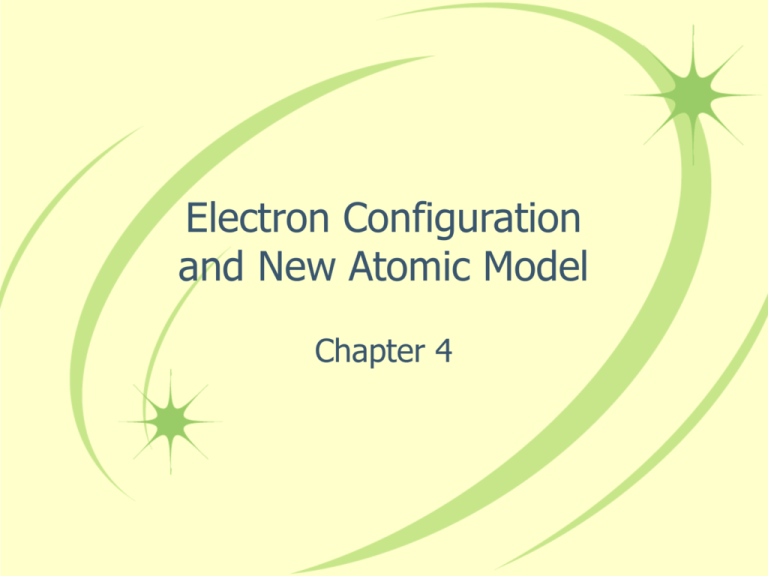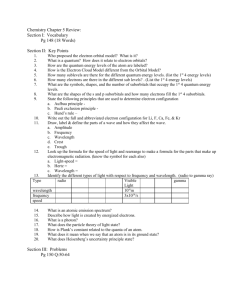Electron Configuration - Warren County Schools
advertisement

Electron Configuration and New Atomic Model Chapter 4 The Key to the New Atomic Model • A connection between light and electrons! • Before the 20th century, it was believed that light behaved only like a wave. • To fully understand the connection between light and electrons, we must review the properties of light. Electromagnetic Radiation • A form of energy that exhibits wavelike behavior as it travels through space is called electromagnetic radiation. • All forms of this radiation make up the electromagnetic spectrum. • All forms move at the speed of light (c= 3.0 x108 m/s), through a vacuum and slightly slower through matter. • We can assume that it moves that fast through air because it is mostly empty space. Electromagnetic Spectrum Features of Light • Wavelength ()- is the distance between corresponding points on adjacent waves. • Units are either in meters, centimeters or most commonly nanometers. • 1 nm= 10-9 m Features of Light • Frequency ()- the number of waves that pass a given point in a specific amount of time, usually in one second • Unit- Hertz (waves/second) • Higher frequency equals shorter wavelength. • Lower frequency equals longer wavelength. • They are related by the following equation: c= The Photoelectric Effect • One experiment completed in the early 1900s challenged the wave theory of interaction between light and matter. • The photoelectric effect refers to the emission of electrons from a metal when light shines on it. • The wave theory of light predicted that any frequency of light would supply enough energy to eject an electron. • However, in this experiment, electrons weren’t emitted if the light’s frequency was below a certain level. Particle Description of Light • Max Planck- a German physicist who studied the emission of light from hot objects • Hot objects do not continuously emit electromagnetic radiation, as they would if they were in the form of waves. • Planck suggested that hot objects emitted energy in small, specific amounts called quanta. Relationship between Quanta and Frequency of Radiation • A quantum is the minimum energy lost or gained by an atom. (plural=quanta) • Planck’s proposed relationship: E=h • E= energy in Joules of a quantum of radiation, is the frequency, h is a constant, known as Planck’s constant: 6.626 x 10-34 J•s. Wave-Particle Duality • Einstein took Planck’s idea further and proposed that electromagnetic radiation has a dual wave and particle nature. • Light has wave-like properties but can also be thought of as a stream of particles. • Each particle of light carries a quantum of energy. • He called these particles photons. • A photon is a particle of electromagnetic radiation having zero mass and carrying a quantum of energy. Einstein explains the Photoelectric Effect • Electromagnetic radiation is absorbed by matter only in whole numbers. • In order for an electron to be ejected from a metal surface, it must be struck by a photon that has the minimum required energy. • This corresponds to a minimum frequency. • Since electrons are bound more or less closely, depending on the metal, the frequency required to remove an electron is different for different metals. Energy of Atoms • The lowest energy state of an atom is called its ground state. • The state in which the atom has a higher potential energy than its ground state is called its excited state. • When an excited state atom returns to the ground state, it gives off energy in the form of electromagnetic radiation, or light. Emission Spectra • Emission spectra are bands of light at specific frequencies (and therefore wavelengths) that result when the light emitted from an element. • This spectra can be observed when the element is in gaseous form and has a current running through it or when it is being burned. Emission Line Spectra of Hydrogen • What was expected to be observed from hydrogen was a continuous spectrum. • Since this was not observed, attempts to explain this resulted in a new theory of the atom called quantum theory. Fixed Energy • Because hydrogen • When an excited emits light at specific hydrogen atom returns frequencies, the energy to its ground state, a differences between photon of radiation is these states must be emitted. fixed. • The energy of the photon is equal to the • So a new model of hydrogen must be difference between the created! initial and final states. Bohr Model of Hydrogen • Niels Bohr proposed a model of the atom that linked it’s electron with the photon emission. • According to his model, the electron could circle the nucleus in allowed paths called orbits. • The electron is in lowest orbit when closest to the nucleus, and therefore has the lowest energy. • When the energy of the electron becomes higher, it orbits further from the nucleus. Bohr’s Results • He matched the spectral lines produced for hydrogen to the energies that hydrogen would allow for electrons. • The mathematics supported the experimental data! • The discovery of the new model for the hydrogen atom was thought to apply to all other atoms. • However, it was soon discovered that his model did not work for atoms with more than one electron. Quantum Model of the Atom • Scientists struggled with the notion that electrons could only exist in certain orbits with definite energies. • They did not understand why there couldn’t be a limitless number of orbits with slightly different energies. • Louis de Broglie, a French scientist, investigated this very question in 1924. • What he found would change our understanding of matter forever. Quantum Model of the Atom • De Broglie suggested that electrons be considered waves that are confined to the spaces around the nucleus. • His theory about electrons behaving like waves was soon proven to be correct by experimentation. • Electrons can be bent or diffracted. • Diffraction refers to the bending of a wave as it passes by the edge of an object. • It was also shown that interference occurs when waves overlap, causing a slight decrease in energy. Heisenberg Uncertainty Principle • Scientists wondered where electrons were in the atom, because they could not be detected with photons since the energy of a photon would send an electron off its current path. • The Heisenberg Uncertainty principle says that it is impossible to determine simultaneously both the position and velocity of an electron or any other particle. Schrödinger Wave Equation • Schrödinger developed an equation based on the theory that electrons have a dual wave-particle nature. • Together with the Heisenberg uncertainty principle, the new equation led to modern quantum theory. • Quantum theory mathematically describes the wave properties of electrons. • Quantum theory determined that wave equations give only the probability of finding an electron at a given place. Quantum Numbers • Numbers used to specify the properties of atomic orbitals and properties of electrons in those orbitals • There are 4 quantum numbers. • First three are from Schrödinger's equation • 1) Principal Quantum number- (n) indicates the main energy level occupied by an electron -all are whole numbers - as number increases the average distance from the nucleus increases Quantum Numbers • 2) Angular Momentum Quantum Number- (l) indicates the shape of an orbital • The number of orbital shapes possible is equal to n-1. • Zero counts… • So for a value of n=2, there are a total of 2 l values, l=0 and l=1. • The value of l is then assigned a letter: • L=0 s • L=1 p • L=2 d • L=3 f Orbital Shapes • An s orbital is spherical. • A p orbital is dumbbell shaped. • A d orbital can be clover shaped. • An f orbital is really complex. Quantum Numbers • 3) Magnetic Quantum numbers(m) indicates the orientation of an orbital around the nucleus • In each s sublevel, there is only 1 orientation because it’s a sphere. • In a p sublevel, there are 3 orientations because the dumbbell can be aligned on the x, y or z axis. • In a d sublevel, there are 5 orientations. • In an f sublevel, there are 7 orientations. Spin Quantum Numbers • Electrons can be thought to spin on an internal axis. • It can spin in one of two possible directions. • The spin quantum number can have only 2 possible values: +1/2 or -1/2, which indicate direction of spin. • A single orbital can hold a maximum of 2 electrons which must have opposite spins!!!







